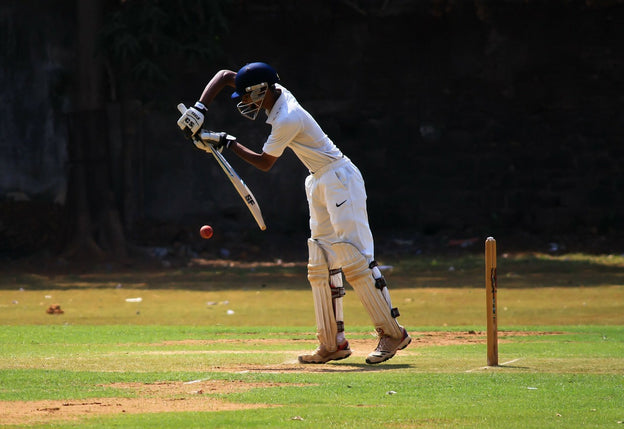Cricket Ball Weight & Cricket Ball Basics: Materials, Sizes, and More. What Makes the Cricket Balls Great for 2.5 Billion Global Fans
Cricket is one of the most popular sports in the world, with more than 2.5 billion fans worldwide. The sport dominates in countries like India, Australia, Pakistan, Bangladesh, New Zealand, and South Africa, where cricket enthusiasts are always seeking to understand every aspect of the game.
This comprehensive guide explores everything about cricket balls: how heavy is a cricket ball, manufacturing processes, official specifications, and why these details matter for players and fans alike. Whether you're a beginner wondering about international cricket ball weight or an experienced player seeking the perfect ball, this article has you covered.
What Materials Are Used to Make Cricket Balls?
Generally, professional cricket balls are made from three different materials: leather, cork, and string. Cork makes the ball's core. The string is then used to wrap the core many times over for reinforcement.

Cricket ball leather is used to wrap both the string and cork. Normally, the leather is dyed red (which shows that it is to be used in test and first-class matches) or white (indicating that they should be used for Twenty20 and one-day matches).
Check this out:
The cricket ball construction may feature two or four pieces depending on the level of cricket. Regardless of whether it is a two-piece or four-piece ball, the common thing is that two hemispheres will be joined at the ball's equator using several stitch strings.
Cricket balls are hard and shiny. Since the game involves fast bowling at high speeds towards another person, it is vital that the players wear protective gear like arm guards, pads, and helmets.
Cricket Ball Official Dimensions and Why They Matter
The cricket ball size and weight differ based on the cricket level being played. Understanding cricket ball specifications is crucial for players, coaches, and equipment buyers.
Here are the official cricket ball weight standards:
For men's cricket ball weight, the official ball weighs between 155.9 and 163 grams. The ball's circumference is between 22.4 and 22.9 centimeters. This international cricket ball weight standard ensures consistency across all professional matches worldwide.
For women's cricket ball weight, the ball usually weighs between 140 and 151 grams. It has a circumference of between 21 and 22.5 centimeters.

For junior cricket ball weight that is played by people under 13 years old, the balls weigh between 133 and 144 grams. Also, the circumference lies between 20.5 and 22 centimeters. With these cricket ball dimensions, you now know what ball size to buy.
Why Cricket Ball Weight Matters for Performance
How heavy is a cricket ball directly impacts bowling speed, swing movement, and batting performance. The standardized weight ensures fair play and consistent ball physics across different cricket formats and venues.
Rules of Using Cricket Balls in Matches
There are certain cricket ball regulations that stipulate how the ball should be handled. In case a cricket ball is damaged, it must be replaced before the game proceeds. It is required that a new cricket ball be used at the beginning of every new inning whether or not the batting team is following on.
Now:
In the event that the match goes for more than a single day, it is required that the ball be replaced after a certain number of overs. While there are some variations in the limit after which a replacement cricket ball can be used, the general rule of thumb is that 75 overs must not be exceeded before a new ball is used. In first-class cricket and test cricket games, the fielding team may decide to use a new ball after 80 overs.
In case the ball is damaged beyond use or lost (such as when a player knocks it far from the ground), the players should use a cricket ball in similar condition as a replacement.
Cricket Ball Colors and Their Uses
Usually, red cricket ball is the color used for traditional cricket. Ever since the debut of limited-overs cricket that were played under floodlights, white cricket ball has become the de-facto ball color for Twenty20 and one-day matches regardless of whether the matches are played during the day or at night.

Players have also experimented with other colors such as orange cricket ball and pink cricket ball, but white still remains the standard for day-night cricket.
The Best Cricket Ball Manufacturing Brands
The largest cricket ball manufacturer on the planet is Kookaburra cricket balls, which is based in Australia. You will find Kookaburra balls used in every Twenty20 and one-day matches.
They are also common in many Test matches. Dukes cricket balls are used in matches played in the West Indies and England. SG cricket balls (such as the SG Seamer) are very popular in Test matches played in India.
Kookaburra Cricket Balls: What Makes Them Popular
Kookaburra has been manufacturing premium cricket balls for 125 years. Thanks to their experience, the brand is considered one of the world's best. Kookaburra balls are made from some of the highest quality raw materials and modern technology.
Here's an amazing fact...

Why the Turf Cricket Ball is Such Huge Success
The turf cricket ball is the flagship of the Kookaburra cricket ball lineup and meets all international cricket ball weight requirements.
At its core, the ball is made of cork. There are five layers of natural cork and worsted yarn built onto the cork's nucleus, which is then finished with a generous layer of worsted winding. The cricket ball leather cover is made from selected alum tanned steer hide that is cut into four sections.
Here's why this is important:
The five layers of cork are what distinguish Kookaburra cricket ball construction from other manufacturers. Most of Kookaburras' competitors manufacture their balls using a single molded center.
However, Kookaburra believes that the five layers help make the ball more consistent and controllable, which is great for cricket ball performance. This ensures the predictability of the ball's bounce throughout the cricket match.
The White Cricket Ball - In the Footsteps of the Red Turf Ball
Kookaburra started making the white turf cricket ball in 1977 after being approached by the Nine Network and Kerry Packer. The objective was to have a ball that could be used in one-day cricket and day-night cricket matches, which would be played in the evening (known as the World Series Cricket).
Kerry Packer wanted a white ball that would play as similarly as possible as the red ball. As such, Kookaburra made the white ball using the exact same process as the red ball, maintaining the same cricket ball weight specifications.
I won't lie to you:
The only difference is that the leather used to make the white cricket ball is natural and comes in an off-white color. Kookaburra covered the leather with a pigmented pure white finish to make sure that it retains its high visibility through many games.
The major issue with the white ball is discoloration. In the course of its use, the ball scratches and wears. Also, it picks up contamination on the surface and becomes decolorized. As such, it is required that two new white cricket balls be used in each inning, where a different ball is used at each bowling end.
Pink Cricket Ball - Let's Play Cricket Under Lights
Thanks to the success of the white turf ball and the demand for cricket under lights, the Marylebone Cricket Club, the International Cricket Council and Cricket Australia approached Kookaburra to help create a pink cricket ball that would initialize the process of getting cricket to be played under lights.
In the past, pink balls have been used for four-day cricket and five-day cricket games. Since these longer forms of cricket were to be played in cream or white clothing, it was important for the ball's color to contrast with the players' uniforms.
The result?
Pink cricket ball has proved to have a great contrast for both day and night cricket games. Pink is also ideal because it has high visibility in all the stages of its natural deterioration. The pink Kookaburra turf ball is currently being used in trials around the globe.
Just recently, the pink ball was used in the first day-night test match under lights between New Zealand and Australia at the Adelaide Oval in November 2015. In fact, there is no other ball that has been through the same number of trials and testing like the pink ball.
Look:
Worth noting is the fact that the pink cricket ball is made using the exact same process used to make the red turf ball, maintaining identical cricket ball weight standards. The only difference is that in the former, there is an extra layer of pink that is added to the standard lacquer finishing that is standard in all Kookaburra balls.
Also, the pink turf ball uses green stitching, unlike the white stitching that is used on red turf balls.
How Long Does It Take To Make A Cricket Ball?
It takes between two and three weeks to manufacture a professional cricket ball. The actual cricket ball manufacturing process takes less than the two and three week period.
So why the extra period?
The additional time is there because the balls need a rest period where they settle, acclimatize and get used to how they have been combined and molded during the cricket ball production process.
Men's, Women's and Youth Cricket Ball Specifications
Cricket ball weight and dimensions come in different specifications for men, women and youth games. Understanding how heavy is a cricket ball for each category is essential:
In the men's cricket category, the balls are between 155.9 and 163 grams with a circumference of between 224 and 229 mm. This international cricket ball weight standard applies globally.
In the women's cricket category, the balls weigh between 140 and 151 grams with a circumference of between 210 and 225 mm.
Youth cricket balls weigh between 133 and 144 grams and have a circumference of between 205 and 220 mm.
How Many Different Cricket Balls Does Kookaburra Make?
Kookaburra cricket ball range includes more than 50 different types of cricket balls. These balls are made in different grades, colors, and size. Despite the wide array of cricket balls, each one is manufactured with great care, and their subtle differences make them ideal for different cricket playing conditions. The balls are manufactured in a cutting-edge factory in Melbourne, Australia.
Now:
Despite the fact that the Kookaburra turf ball is one of the top balls in the world, the company makes many other types of cricket balls. These are targeted for use in the state cricket, provincial cricket, junior cricket and club cricket games.
Kookaburra also manufactures balls that are suitable for indoor cricket and junior games. Kookaburra also offers the Super Coach cricket ball range that is suitable for a wide range of bowling and batting like swings, bounces, and spins.
Conclusion
Understanding what goes into making a quality cricket ball is important for cricket players and fans alike. Knowing how heavy is a cricket ball and international cricket ball weight standards helps justify the price tag attached to professional balls. By selecting the right cricket ball brands from companies with a great heritage, you set yourself up for success.
This comprehensive guide has explored cricket ball specifications, their materials, weights, sizes, colors and history. We have also discussed the Kookaburra cricket balls and what makes them the preferred choice for professional cricket.
Cricket Store Online stocks the best quality cricket balls at competitive prices from Kookaburra and other leading cricket ball manufacturers. You can browse through collections of premium cricket balls and other cricket accessories. We guarantee nothing but high quality and supreme customer service for all your cricket gear needs.


